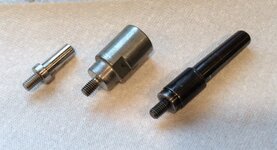Should I use a live center for the tail stock or a drive center. When turning? I've seen both. I've also seen the same B.S. mandrels e used to turn other things like handles for scoops, bottle openers, etc. What would be best? Live or drive.
Basic principles:
Typically, you always start a spindle turning such as a bottle stopper 'between centers'. That means that the blank is held between two point that are aligned to the centers of the ends of the blank and that define the axis of rotation.
The lathe motor drives the headstock spindle. Therefore, you need a rigid connection between the headstock spindle and the blank. That rigid connection can take one of several forms - a chuck, a mandrel, or a 'dead' center. Dead centers are also called 'drive centers'.
Actually, drive (dead) centers come in several varieties. Almost all new lathes come equipped with a 'spur drive' - a dead center with a center point and four flat blades. Some people prefer spur drives with only two blades. In either case, this is a single piece of steel that is machined to have a rigid point that is used to center the blank, and two or four blades that dig into the end-grain of the timber to create the rigid connection to the blank. The other end of most spur drives has a male 'Morse taper' that matches the female taper inside the lathe headstock spindle; the dimensions of Morse tapers are defined in industry standards. The most common Morse taper on lathes is No 2; some entry-level mini-lathes have the smaller No 1 Morse taper, while some larger lathes have the No 3 taper. The basic idea behind Morse tapers is that if the male and female tapers match, then the two can be simply slid together to create a rigid connection that transfers rotational energy with little or no frictional loses, but that can also be easily separated simply by tapping the small end of the male taper.
Another very common form of dead/drive center is generically called a 'crown drive', but commonly referred to as a 'steb center' - 'Steb Center' is actually the tradename of a specific product manufactured by Robert Sorby in England. The perimeter of this drive features a ring of sharp points that grip the end grain of the wood, together with a spring-loaded center point to align the blank. The advantage of steb centers is safety - the blank is only loosely held by the points on the perimeter of the drive, and if something happen to cause the blank to stop rotating (this is called a 'catch'), the wood will just spin. I always use a steb center rather than a spur drive.
The other end of the blank is held on the tailstock. Since the blank will be rotated from the headstock end, the connection between the blank and the tailstock must be able to spin freely. In the distant past, the practice was to use simple spike stuck into the end of the blank, and to periodically apply some kind of lubricant so that the wood could spin freely against that fixed point. Today, we use 'live centers' for this purpose. Live centers fit between the blank and the tailstock and contain internal bearings to allow free rotation. The actual point of contact between the blank and the live center can have a variety of configurations depending on the circumstances. When turning 'between centers', the usual arrangement is to use a live center with either a small point, or a pointed cone.
The context for the question was turning bottle stoppers. In general, the steps involved in making a stopper are:
1. Mount the blank between centers, and turn it to form a cylinder.
2. Mount the cylinder in a scroll chuck, and then drill and tap a hole in what will become the bottom of the finished stopper to accept the threaded stud on the mandrel.
3. Remount the blank on the mandrel and finish the turning.
It is possible to drill and tap the hole off the lathe before rounding to a cylinder. Taking that simpler approach eliminates the 'between centers' step, but it also means that the range of options for finishing the bottom of the stopper is limited.
It is not absolutely necessary to have tailstock support after the blank has been mounted on the mandrel. However, most turners understand that gripping the blank at both ends is far more secure, and therefore far safer, than holding it only at the headstock end, and therefore continue to use tailstock support with a live center for as much of the turning process as possible. The tailstock can be backed away in the final stages of the process to finish off the very top of the stopper.

